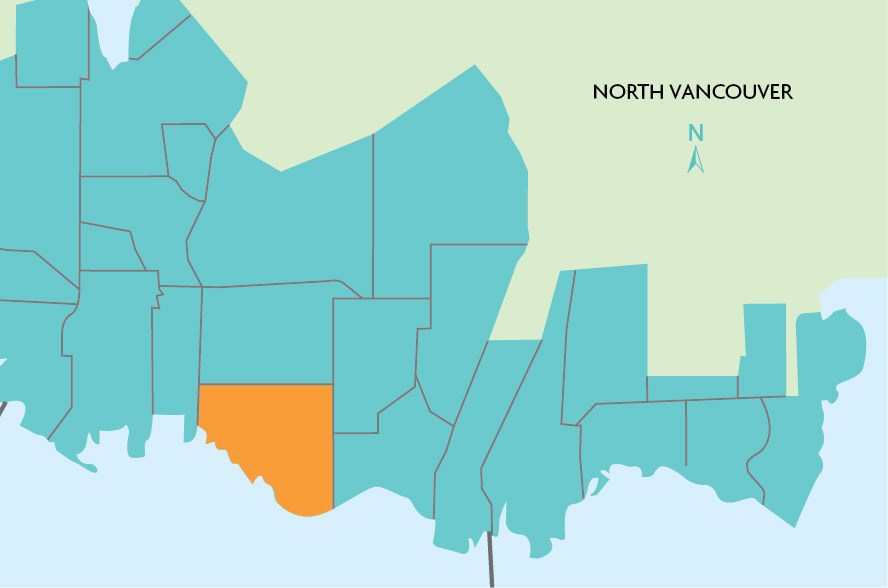Nellie Paddon was born on Dec. 2, 1884, and lived on Connaught Street in North Vancouver. She was hired on Dec. 16, 1943.
Hans Peter Lauridson was born on Oct.1, 1921, and lived on Roosevelt Crescent. He was hired on Sept. 11, 1944. He returned to the Merchant Marines on Jan. 24, 1945, at age 24.
Along with Harvey Emil, Robert C. Gardner, Edith Charlotte Dyer, and many others, these names represent people who all worked the first of three rotating, round-the-clock shifts at Burrard Dry Dock.
They are among the estimated 14,000 men and women who built ships at the company during the Second World War.
Copies of their employee records are now on display as part of an art installation called The Big Drawer, an outside steel-and-photo collage monument to shipyard workers that marks the original entrance to the Burrard Drydock Shipyards and the location where workers punched their time cards, according to the City of North Vancouver website.
Originally opened in 1906 as Wallace Shipyard, the site was renamed in 1921 as Burrard Dry Dock. More than 450 ships were launched from the site.
Burrard Dry Dock and its neighbour, North Van Ship Repairs, built approximately one third of Canada’s Victory ships. The Burrard Dry Dock Pier was built in 1925 for the wartime shipbuilding effort, noted the website.
The shipyard closed in 1992, and after discussions about what if any of it to preserve, it was decided to keep the Coppersmith and Pipe Shops, as well as the pier.
Shipbuilding was a big part of the history of Lower Lonsdale, but the neighbourhood started out centered around a sawmill.
According to the Encyclopedia Brittanica online version, a sawmill was built in Lower Lonsdale in 1863 and was the largest European settlement on the
Burrard Inlet for many years. However, the territory had been home to the Coast Salish people and the Squamish, their descendents, for many centuries before European arrival.
The area around the sawmill was named Moodyville in 1872 after Sewell Moody, who owned the company.
The District of North Vancouver was established in 1891 and included territory along the shore of the inlet, except for Moodyville. In 1907 the City of North Vancouver seceded from the district and was incorporated, and in 1915 it annexed Moodyville. According to a Heritage Vancouver newsletter, the sawmill closed in 1901.
Before 1902, the bottom few blocks of Lonsdale were virtually undeveloped with just a primitive road leading all the way up the hill, according to the book Time Travel in North Vancouver, a Peek into the Past by Sharon J. Proctor. Across the inlet, Vancouver developed faster partially due to its access to the railway. Development of the Lower Lonsdale area depended on improving infrastructure and accessibility.
According to the book North Vancouver’s Lonsdale Neighbourhood by Shervin Shahriari, the city began to take shape in 1903 when Alfred St. George Hamersley purchased a big plot of land and named the area the Town of Lonsdale. He then encouraged more business to move into the area.
Fun fact: Originally Lonsdale Avenue just went straight up the hill. Now it levels off at each cross-section.
The introduction of streetcars helped connect neighbouring areas, and by 1907 the city boasted 20 miles of sidewalk, according to the City of North Vancouver website.
North Vancouver’s ferry (Ferry #5) made its final scheduled trip to the Lonsdale wharf in 1958. However, some readers may remember that it then became a floating restaurant called Ship of the Seven Seas, and later Seven Seas Seafood. It remained in its berth at the foot of Lonsdale until 2001.
Today, the loose boundaries of Lower Lonsdale can be drawn from the water up to Keith Road, Forbes Avenue on the west and St. Davids Avenue on the east. It includes Victoria Park, popping up into East Eighth Street between St. Georges and St. Andrews avenues.

It is a sunny and hot Wednesday afternoon as Dave Symington sits at the outdoor plaza, by the fountain (empty due to current water restrictions) at the south end of the Lonsdale Quay market. He is waiting to meet a friend for lunch but agrees to chat about his time growing up in North Vancouver.
Originally from England, Symington moved to the area in 1957 at the age of two.
He recalls riding his tricycle down the hill all the way from Keith Road to Marine Drive. Smoking was pretty common back then, and Symington remembers finding a pack of cigarettes left behind by some men burning leaves in the back alley by his house. He started smoking at the age of six, but says he didn’t inhale until he was 10.
“I didn’t even know you had to inhale,” he recalls with a laugh.
There were six kids in the Symington household and they all shared an attic bedroom. “I remember it being really fun,” says Symington.
He remembers crying when he started kindergarten and his mom having to rescue him and take him home.
Many kids had mumps and measles back then, he says, and wonders if there weren’t as many vaccinations as there are now.
Symington’s family later moved to Seattle and a few other places, but his grandmother stayed in North Vancouver, still lives here, and Symington often returns to visit.
More travels sent him to Ontario and other places but, he says, “I always knew I’d be back.”
Symington, who uses a wheelchair after experiencing a diving injury when he was 19, taught at Capilano University for a year, filling in for a colleague, and has lived in Lynn Valley and Edgemont. He currently lives in Vancouver but returns to North Vancouver often.
“To me it’s just a little more West Coast,” he notes.



